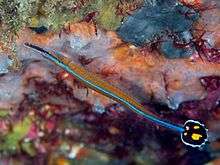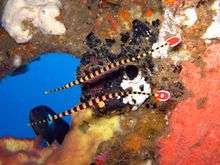Flagtail pipefish
Doryrhamphus and Dunckerocampus, popularly known as flagtail pipefish,[1] are two genera of fishes in the family Syngnathidae. They are found in warm, relatively shallow waters of the Indo-Pacific, with a single species, D. paulus, in the eastern Pacific.[2] Most of these pipefishes are very colourful, and are fairly popular in the marine aquarium hobby despite requiring special care and not being recommended for beginners.[1][3]
| Doryrhamphus Dunckerocampus | |
|---|---|
 | |
| Doryrhamphus japonicus | |
 | |
| Dunckerocampus dactyliophorus | |
| Scientific classification | |
| Kingdom: | |
| Phylum: | |
| Class: | |
| Order: | |
| Family: | |
| Subfamily: | Syngnathinae |
| Genera | |
Their habit of flashing the distinctly patterned tails during courtship and other displays have earned them their English popular name.[1] Adults are highly territorial and usually live in pairs.[1][3] They feed on tiny crustaceans and other small animals, and most species from the genus Doryrhamphus will sometimes act as cleaners.[3]
Description
Doryrhamphus have a maximum length of 14 centimetres (5.5 in) or less, with D. janssi being the only species that surpasses 8.5 centimetres (3.3 in).[2][4] Most species have a horizontal blue line along their body, and all have a whitish-edged tail that is marked contrastingly with black, red or yellow.[2][4]
Dunckerocampus are more elongated and have a maximum length between 10 and 20 centimetres (3.9 and 7.9 in), with D. chapmani being the only species with a maximum length below 15 centimetres (5.9 in).[2][4] Their tail is red with a whitish edge, and in some species there is a white or yellow spot in the center.[2][4] All except D. baldwini (and a similar, but possibly undescribed species from the eastern Indian Ocean) have vertical red/brown and yellow/white stripes on their body.[2][4]
Taxonomy
Considerable taxonomic confusion exists in these genera, both because a number of scientifically undescribed species remain and some of the already described species are variable.[2][5]
The first to recognise the species now placed in Dunckerocampus as worthy of a separate genus was the German ichthyologist George Duncker, and for this reason he coined Acanthognathus in 1912.[6] However, unbeknown to him that name was preoccupied by a genus of ants.[7][8] The replacement name Dunckerocampus honours Duncker.[9]
Following a review in 1985, Dunckerocampus was generally considered a subgenus of Doryrhamphus,[10] but in 1998 it was recommended that Dunckerocampus again should be a genus, and in addition to the species formerly placed in it, it should include the newly described D. boylei.[11] When described in 2004, D. naia was also placed in this genus.[12] Recent authorities generally recognise Doryrhamphus and Dunckerocampus as separate genera.[5][13][14][15]
Species
Species and genera follow most recent reviews of this group.[5][13][14][15]
- Genus Doryrhamphus:
- Doryrhamphus aurolineatus Randall & Earle, 1994
- Narrowstripe pipefish, Doryrhamphus bicarinatus Dawson, 1981
- Bluestripe pipefish, Doryrhamphus excisus Kaup, 1856
- Janss' pipefish, Doryrhamphus janssi (Herald & Randall, 1972)
- Honshu pipefish, Doryrhamphus japonicus Araga & Yoshino, 1975
- Masthead Island pipefish, Doryrhamphus malus (Whitley, 1954) – treated as a species by some authorities,[5][15] and a subspecies of D. negrosensis by others.[13]
- Barhead pipefish, Doryrhamphus melanopleura (Bleeker 1858) – treated as a species by some authorities,[5][15] and included in D. excisus by others.[13]
- Negros pipefish, Doryrhamphus negrosensis Herre, 1934
- Doryrhamphus paulus Fritzsche, 1980 – treated as a species by some authorities,[5][15] and a subspecies of D. excisus by others.[13]
- Genus Dunckerocampus:
- Redstripe pipefish, Dunckerocampus baldwini (Herald & Randall, 1972)
- Broad-banded Pipefish, Dunckerocampus boylei Kuiter, 1998
- Glowtail pipefish, Dunckerocampus chapmani Herald, 1953
- Ringed pipefish, Dunckerocampus dactyliophorus (Bleeker, 1853)
- Many-banded pipefish, Dunckerocampus multiannulatus (Regan, 1903)
- Dunckerocampus naia Allen & Kuiter, 2004
- Yellowbanded pipefish, Dunckerocampus pessuliferus Fowler, 1938
References
- Weiss, T. (2005). Flagtail Pipefish In The Home Aquarium. Archived 2011-10-06 at the Wayback Machine Fusedjaw
- Kuiter, R. H. (2003). Seahorses, Pipefishes, and their relatives. 2nd edition. TMC Publishing. Chorleywood. ISBN 0-9539097-4-3
- Schultz III, H. C. (2003). There's More to Pipes Than Just PVC: The Genus Doryrhamphus and Other Pipefish. Reefkeeping
- Kuiter R. H., & H. Debelius (2007). World Atlas of Marine Fishes. 2nd edition. IKAN Unterwasserarchiv. ISBN 978-3-925919-77-0.
- Kuiter, R. H. (2009). Seahorses and their relatives. Aquatic Photographics, Seaford, Australia. ISBN 978-0-9775372-1-1
- Duncker, G. (1912). Die Gattungen der Syngnathidae. Mitteilungen Naturhist. Museum Hamburg 29: 219-240.
- Mayr, G. (1887). Südamerikanische Formiciden. Verhandlungen der Zoologisch-Botanischen Gesellschaft in Wien 37: 511-632.
- Ride, W.D.L, H.G. Cogger, C. Dupuis, O. Kraus, A. Minelli, F. C. Thompson & P.K. Tubbs, eds. (1999). International Code of Zoological Nomenclature. 4th edition. International Trust for Zoological Nomenclature. ISBN 0-85301-006-4
- Whitley, G. P. (1933). Studies in ichthyology. No. 7. Records of the Australian Museum v. 19 (1): 60-112, Pls. 11-15.
- Dawson, C. E. (1985). Indo-Pacific pipefishes (Red Sea to the Americas). Gulf Coast Research Lab., Ocean Springs, Mississippi. Indo-Pacific pipefishes (Red Sea to the Americas). i-vi + 1-230.
- Kuiter, R. H. (1998). Pipefishes of the syngnathid genus Dunckerocampus (Sygnathiformes: Syngnathidae), with a description of a new species from the Indian Ocean. Aqua, Journal of Ichthyology and Aquatic Biology 3(2): 81-84.
- Allen, G. R., & R. H. Kuiter. (2004). Dunckerocampus naia, a new species of pipefish (Pisces: Syngnathidae) from the western Pacific. Aqua, Journal of Ichthyology and Aquatic Biology 9(1): 1-6.
- Froese, Rainer and Pauly, Daniel, eds. (2012). Species of Doryrhamphus in FishBase. September 2012 version.
- Froese, Rainer and Pauly, Daniel, eds. (2012). Species of Dunckerocampus in FishBase. September 2012 version.
- Eschmeyer, W.N., & R. Fricke, eds. (2012). Catalog of Fishes. Archived 2012-08-24 at the Wayback Machine Online version, 19 September 2012.